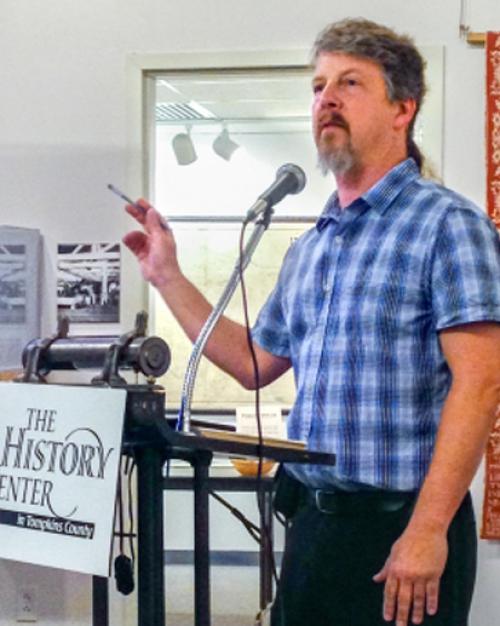Ithaca is dotted with buried Native American sites, according to Kurt Jordan, associate professor of anthropology in the College of Arts & Sciences, who also has an appointment with theAmerican Indian Program in the College of Agriculture and Life Sciences.
Yet these sites are incredibly difficult to comprehend because centuries of residential and commercial development has altered the landscape.
Much of the evidence of indigenous activity collected around Cornell, Ithaca and Tompkins County was so poorly documented that it tells very little about the nature and location of native settlements. Archaeologists today document to the square inch where an artifact is unearthed, but many artifacts in the 19th and early 20th centuries only were vaguely identified as coming from Ithaca or Cornell.
On Sept. 19, Jordan presented “Destroyed, Forgotten, Never Noted: Ithaca’s Hidden Indigenous History” to more than 100 people gathered at the History Center in Tompkins County, located in downtown Ithaca. Jordan told the standing-room-only crowd he has been tracking evidence of Native American presence in central New York his entire career. He has found bits and pieces about the archaeology of Ithaca over the past 20 years, but many of them led to a dead end. Jordan is troubled by a lack of comprehensive, up-to-date information on the region’s Native American presence.
Central New York was first home to the Haudenosaunee, or Iroquois Confederacy, of which the Cayuga nation is a part. Americans were relative latecomers, settling here after the American Revolution around 1790. Jordan’s evidence suggests Cayuga populations were much larger at the north end of Cayuga Lake, where the soil was more fertile and fish more abundant, yet plenty of evidence points to Cayugas in Ithaca, too.
Earlier scholars took little care with artifacts, Jordan said. For example, a set of two fluted stone points was among the oldest artifact found in New York state – dating as far back as 11,000 B.C. The only location information that survives states the stone tools were found in 1957 on “high ground overlooking foot of Cayuga Lake” on Cornell’s campus. The campus, however, overlooks the head of the lake. Cornell had several experimental farms along the perimeter of the lake, so it is possible that the stone points were found in Cayuga County, far from Cornell’s main campus. Although Jordan found pictures of these early objects, no one knows where they are today.
Another set of stone tools collected locally erroneously was cataloged in Cornell’s Anthropology Collections in McGraw Hall as Brazilian, until the error was noted and corrected by curatorFrederic Gleach, senior lecturer and curator of the Anthropology Collections. Given the absence of scrupulous note-taking, Jordan lamented, we will never know the full extent of Haudenosaunee settlement here.
Jordan found that many Native American burial sites were disturbed – knowingly and unknowingly – to build today’s Ithaca. Some American settlers carried off copper kettles for their kitchens from upturned graves. Documentary evidence from 19th-20th-century locals in Cornell University Library’s Rare and Manuscript Collections and the History Center archives mentions that graves were disturbed to build North Geneva, Seneca, Parker and South Aurora streets, as well as the north end of South Hill and the south side of Fall Creek.
Amanda Bosworth, a Cornell doctoral student in history, is a writer intern for the Cornell Chronicle, where this story first appeared.




